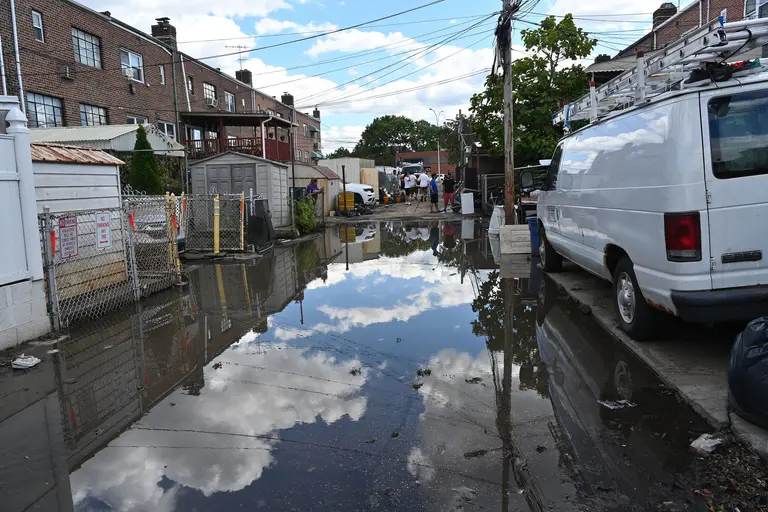Renters insurance in NYC: Why you should get it right now

Renters insurance is one of those things that you know is a good idea–and like so many New York City renters, you’ve been meaning to do it, but you may not have gotten around to it–until you wish you had. And though we hope we’ll never need it, it’s one of the few things in city life that’s simple, inexpensive, and worth every penny. Below, we explain why it’s an important investment to make, how to navigate the process of getting a quote and getting covered, and which provider might be best for you.
Some renters may be under the impression that their landlord’s homeowners’ policy covers the contents of their apartment in the event of theft or damage, but it usually doesn’t. In the case of a burst pipe or a fire, for example, the homeowner’s policy will only cover damage to the building, not items in your apartment that get ruined.
Banks require homebuyers seeking a mortgage to have insurance, but renters aren’t required. US News found that, according to a 2018 survey by the Insurance Information Institute, 91 percent of homeowners had homeowners insurance while only 46 percent of renters had renters insurance. Just because it isn’t required doesn’t mean it isn’t a good idea. Renters insurance is relatively cheap. It’s easy to set up and easy to change or cancel. You’re getting peace of mind–and compensation if something happens to your stuff.
Once you’re covered, if your place is robbed or your upstairs neighbor’s sink overflows and your belongings are destroyed, for example, you can submit a claim and be compensated the replacement value of whatever got ruined or ripped off. You’ll even be covered for stuff that gets stolen while you’re traveling with it, or items you’re keeping in a storage space. You’re also covered if someone else injures themselves in your apartment and holds you liable. And you’ll be covered for the expense of staying in a hotel while damage to your home is being repaired.
What renters insurance does–and doesn’t–cover
Personal property coverage: Renters insurance will generally cover items damaged or lost due to one of the following, according to PolicyGenius: Fire and lightning, windstorm and hail, explosions, riots, damage by aircraft damage by vehicle (not your own), smoke damage, vandalism, theft, volcanic eruption, falling objects, weight of snow, ice, sleet, damage from steam-heating/water-heating appliances/systems, leakage or overflow of water or steam, freezing of plumbing, heating, air conditioning, short-circuit damage caused by electrical appliances.
Sometimes, big-ticket items like jewelry, electronics, and art are covered only up to a certain total value, say $1,500. The good news is that you can easily purchase, for a very small additional cost, a “floater” (sometimes called a rider, scheduled personal property insurance, or endorsement insurance) for those items. The floater also kicks in if those items are accidentally lost. Sometimes optional coverage includes things like water backup insurance. Read the fine print; it’s a good idea to purchase the optional coverage; the cost is generally low and it could end up saving you thousands.
In addition to coverage for your personal possessions, renters insurance offers liability coverage up to the policy’s limit, usually at least $100,000. This protects you financially in the case of lawsuits for bodily injury or property damage done by you, your family members, or pets. For example, if you’ve caused a leak that damages your neighbor’s apartment, your neighbor’s damage is covered by your policy. Renters insurance policies are also likely to provide no-fault medical coverage for someone who is injured in the renter’s home.
Your coverage will also provide additional living expense coverage for hotel bills, temporary housing, meals, and other expenses–while your home is being repaired or rebuilt. Though your policy will likely have a timeline or a price cap on this, it’s good to have in an emergency
Of course, there are some exceptions. Most renters insurance policies do not cover damage from floods (you can get flood coverage from the federal government and a few private insurers), earthquakes, natural disasters, pests (like bedbugs, though some providers often a bedbug rider), terrorism, or war.
Some policies will refuse to cover certain breeds of dog, or your premium may be higher with certain kinds of pets. And most policies won’t cover anything that happens in a sublet situation or if someone is renting your place through Airbnb. Items used for business only may not be covered, though you may be able to get a floater for them.
So, if I submit a claim, do I get the amount of money it will cost to replace my things? The compensation you receive in the event of a claim depends on which type of policy you have, so it’s important to make this distinction when you choose one. There are two basic types of coverage: Actual cash value pays to replace your personal property at its depreciated value, up to the policy’s limits. Replacement cost coverage pays to replace your personal property at its actual cost rather than the depreciated value, up to the policy’s limit. Replacement cost coverage generally costs about 10 percent more, but it’s more likely to provide enough compensation to actually replace your things.
How much does renters insurance cover, in total? According to PolicyGenius, common coverage amounts are as follows:
- $25,000 personal property damage coverage: Covers the cost of replacing or repairing your belongings if they’re damaged or stolen.
- $300,000 personal liability coverage: Covers legal costs from damage or injury that occurs in your apartment.
- $2,000 medical payment coverage: Covers medical expenses for anyone injured in your apartment.
- $10,000 loss of use coverage: Covers the cost of lodging, food, and more if your apartment becomes unlivable due to damage.
An insurance claim can be paid very quickly, from a few days to a few weeks, depending on the insurance company and the claim itself.
Who’s covered?
Besides yourself, your policy will usually cover a spouse or domestic partner and other immediate family members who live with you.
What about my roommate? Most policies will cover one roommate, but they must be named on the policy. For this reason, don’t assume you’re covered under your roommate’s renters policy unless you are specifically named. Also, if you make a claim, both you and your roommate will get equal shares of the payment–regardless of whether the roommate still lives with you–so remember to take your roomie off the policy if they move out. Most policies won’t cover additional unrelated roommates–they’ll have to get their own policies
How much does it cost?
According to US News, a typical renters insurance policy is about $185 per year according to the National Association of Insurance Commissioners (NAIC); the Insurance Information Institute says the average policy costs $300 a year according to PolicyGenius. Monthly premiums average between $11 and $21 per month. The cost of a renters policy depends on the total value of what you’re insuring, your location, your credit score, and what type of policy you select.
Deductibles are how much you pay out of pocket towards a claim before the insurance kicks in. Generally, you can choose policies with higher or lower deductibles. Renters insurance deductibles generally are between $250 and $1,000. Higher deductibles usually mean lower premiums.
What can help offset your cost? This varies between providers, but some things that can get you a discount on your premiums include security systems, deadbolt locks, good credit, and holding multiple insurance policies (such as auto insurance) with the same provider.
How do I know which provider to choose?
As we’ve mentioned, this can depend on your specific needs, but most renters’ policies are fairly similar to one another. Find out about monthly premiums, deductible options, any extra things that are covered, upper limits and caps are for claims and what restrictions the policy may have. Less crucial things to look at include whether there’s an app or online assistance for questions and claims. Most big-name insurers have good policies, comparable premiums and offer similar coverage. Lemonade, an industry “disruptor” that entered the field in 2015 gets high marks.
Among the top insurance providers, there are few big differences; premiums may vary, but only within a small range. According to USNews, for example, sample monthly premiums for Lemonade are $11.25 a month, vs. $21 a month for Allstate. Deductibles may vary slightly; some things may be included in base costs, others may need a floater; it comes down to what’s important to you. Make sure you check out the fine print as far as coverage. USAA, for example, is one of the only providers that covers (weather-related) flood damage, but it’s only available to military personnel, veterans, and their families
Ok, I’m ready, So what’s the first step? You’ll need to take inventory of your stuff. This is really the only work you’ll have to do in the process, and it’s easier than you think. You can do it on your own, taking pictures of whatever you’d want to be covered and jotting down either how much you paid for those items or how much it would cost to replace them. Doing a video walk-through to document each item helps, too. There are home inventory apps like Encircle that let you photograph and document items straight from your mobile device. Allstate offers a Digital Locker app for its customers.
You can contact an insurance broker to help you compare policies to find the one that best suits your situation. Online brokerage websites with comprehensive comparisons, like PolicyGenius, are good for comparing several companies at once and can guide you through the process from start to purchase. Consumer-focused publications sometimes cover renters insurance. Once you’ve identified your provider and your policy, you can get started–and give yourself one less thing to worry about.
RELATED:




























